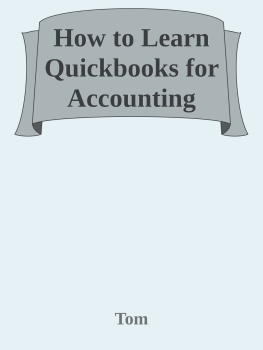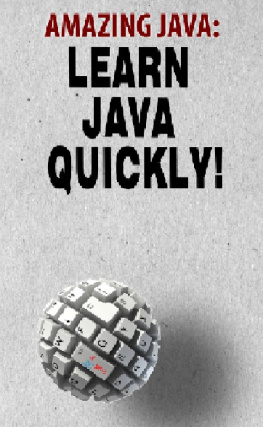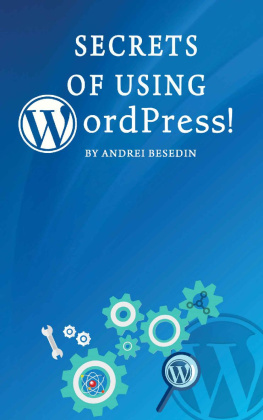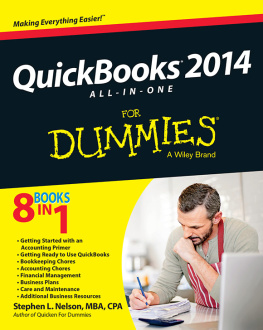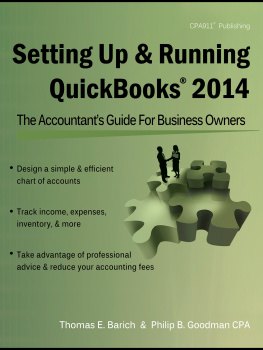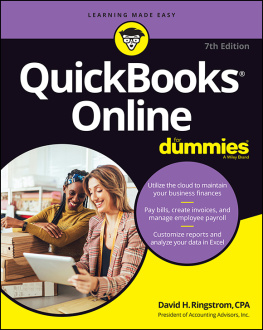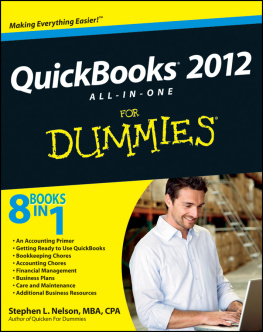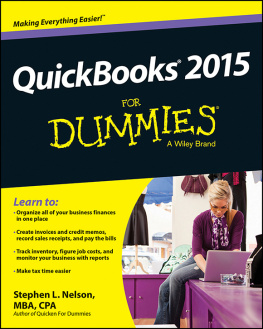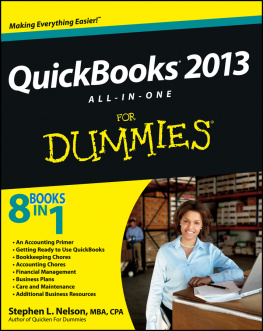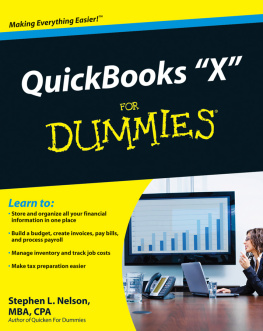How to Learn QuickBooks For Accounting Quickly!
By
Andrei Besedin
Copyright 2018
Table of Contents
About The Author
Other Books By (Author)
Legal Notes and Disclaimer
Text Copyright [Andrei Besedin]
All rights reserved. No part of this guide may be reproduced in any form without permission in writing from the publisher except in the case of brief quotations embodied in critical articles or reviews.
Legal & Disclaimer
The information contained in this book and its contents is not designed to replace or take the place of any form of medical or professional advice; and is not meant to replace the need for independent medical, financial, legal or other professional advice or services, as may be required. The content and information in this book havebeen provided for educational and entertainment purposes only.
The content and information contained in this book havebeen compiled from sources deemed reliable, and it is accurate to the best of the Author's knowledge, information,and belief. However, the Author cannot guarantee its accuracy and validity and cannot be held liable for any errors and omissions. Furthermore, changes can be periodically made to this book as and when needed. Where appropriate and necessary, you must consult a professionalbefore using any of the suggested remedies, techniques, or information in this book.
Upon using the contents and information contained in this book, you agree to hold harmless the Author from and against any damages, costs, and expenses, including any legal fees potentially resulting from the application of any of the information provided by this book. This disclaimer applies to any loss, damages or injury caused by the use and application, whether directly or indirectly, of any advice or information presented, whether for breach of contract, tort, negligence, personal injury, criminal intent, or under any other cause of action.
You agree to accept all risks of using the information presented in this book.
You agree that by continuing to read this book, where appropriate and necessary, you shall consult a professional before using any of the suggested remedies, techniques, or information in this book.
Introduction
This book is meant to enable you to better manage your business finances by guiding you through the basics of keeping adequate records for your farming operation using QuickBooks. It will guide you through the process of creating a company files in QuickBooks, setting up a chart of accounts, and creating customer and vendor lists. The tutorial will show you how to track your bills in QuickBooks and better ensure they are paid on-time. It will also show you how to track your sales and create invoices and sales receipts for your customers. As you regularly and accurately enter all your record keeping information into QuickBooks, you will be able to make use of the many financial reports QuickBooks can generate and make available for you to manage better and analyze your business performance.
With QuickBooks, you can utilize the accompanying records to dissect your business:
Chart of Accountsfor sorting out your day by day exchanges.
Items Listfor following the productivity of individual administrations and items sold.
Class Listfor following distinctive corporate benefit focuses (divisions).
Customer Type ListCapability to see your gross benefit by client characterized client composes.
Chart of Accounts
The chart of accounts is a rundown of benefit, obligation, value, wage, and cost records to which you allow your everyday exchanges. This rundown is a standout amongst the most imperative records you will use in QuickBooks; it encourages you to keep your money related data sorted out. At the point when this rundown is made with outline records,and you utilize the other rundown composes for detail, you can catch data in an auspicious way, which will enable you to settle on great monetary and administration choices for the business.
Account Types
Understanding the graph of records is not muddled. There are six standard record classes utilized for following the budgetary movement of your business: resources, liabilities, value, salary, cost of merchandise sold, and cost.
Assets
Assets incorporate something you have obtained in the past that will be utilized as a part without bounds to produce a monetary advantage. QuickBooks offers these classifications at the request of how fluid the advantage isor in straightforward terms, how rapidly you can transform the benefit into money:
Bank used to track your trade out and out of business. This record composes and the charge card account composes the main record writes you can choose as the installment account in the Pay Bills or Write Checks discourse box.
Accounts Receivablethis record composes requires a Customer or Customer and Job name with every passage. You utilize this record compose while creating a receipt or credit reminder exchange or while accepting a client installment. You can make more than one Accounts Receivable record if necessary. Nonetheless, I do not suggest it since it includes the additional work of recording client installments to the right Accounts Receivable record.
Fixed Assetused to track buys of substantial property that will havea helpful existence of longer than one year. Aggregated Depreciation sums are likewise held in this record written as a negative settled resource.
Other Assets: Intangible resources that have an existence of over one year; additionally any benefit that isn't a Fixed Asset or Current Asset.
Liabilities
Liabilities are the obligations the organization presently can't seem to pay. QuickBooks incorporates these subgroups:
Accounts Payablethis record composes is saved for the QuickBooks Accounts Payable record where merchant bills and bill installments dwell. You can make numerous Accounts Payable records. Be that as it may, I do not suggest it as it includes many-sided quality in the entered bill and pay charge forms.
Credit Cardsoptionally, utilize this gathering to track the charges and installments made against an organization MasterCard. One advantage is that you can accommodate this record as you do your financial balance and furthermore download your MasterCard exchanges specifically into QuickBooks.
Other Current Liabilitythis is an obligation that is relied upon to be paid within one year. This gathering incorporates the QuickBooks-made Payroll Liabilities record and Sales Tax Payable record, notwithstanding other client characterized risk accounts.
Long-Term Liabilitythis is an obligation that won't be paid inside one year.
Value
The Equity account classification holds the proprietors (or proprietors') leftover enthusiasm for the business after the liabilities are paid. Records in this classification incorporate normal stock; proprietor's ventures and draws; held profit; and opening parity value.
Salary
Cash earned from the offer of your items or administrations is recorded as salary. Your organization may have one salary account or a few, contingent upon the detail required for your budgetary investigation. Another class of salary is Other Income, or pay created from the offer of an item or administration not ordinary to your tasks. Intrigue Income is a case of the Other Income account writes.
Cost of Goods Sold
The Cost of Goods Sold record is for costs identified explicitly with creating an administration or useful available to be purchased. There is an immediate connection between these expenses and your income. If your organization offers an item, your cost of merchandise sold (COGS) costs would be the material, work, and different costs brought about to make an offer the item. By differentiate, your office costs for lease or publicizing are viewed as circuitous and ought not to be presented on the Cost of Goods Sold record write.
Next page
